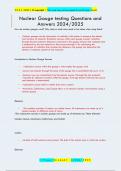Exam (elaborations)
Nuclear Gauge testing Questions and Answers 2024/2025
- Course
- Institution
How do nuclear gauges work? Why does so much care need to be taken when using them? Nuclear gauges use the interaction of radiation with matter to measure the density and moisture of material. Radiation sources within each gauge transmit radiation through the test material. Detectors conta...
[Show more]



